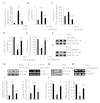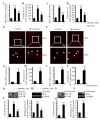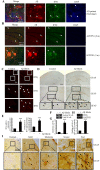Prostaglandin I₂ Attenuates Prostaglandin E₂-Stimulated Expression of Interferon γ in a β-Amyloid Protein- and NF-κB-Dependent Mechanism
- PMID: 26869183
- PMCID: PMC4751455
- DOI: 10.1038/srep20879
Prostaglandin I₂ Attenuates Prostaglandin E₂-Stimulated Expression of Interferon γ in a β-Amyloid Protein- and NF-κB-Dependent Mechanism
Erratum in
-
Addendum: Prostaglandin I2 Attenuates Prostaglandin E2-Stimulated Expression of Interferon γ in a β-Amyloid Protein- and NF-κB-Dependent Mechanism.Sci Rep. 2022 May 19;12(1):8394. doi: 10.1038/s41598-022-12462-4. Sci Rep. 2022. PMID: 35589946 Free PMC article. No abstract available.
Abstract
Cyclooxygenase-2 (COX-2) has been recently identified as being involved in the pathogenesis of Alzheimer's disease (AD). However, the role of an important COX-2 metabolic product, prostaglandin (PG) I2, in AD development remains unknown. Using mouse-derived astrocytes as well as APP/PS1 transgenic mice as model systems, we firstly elucidated the mechanisms of interferon γ (IFNγ) regulation by PGE2 and PGI2. Specifically, PGE2 accumulation in astrocytes activated the ERK1/2 and NF-κB signaling pathways by phosphorylation, which resulted in IFNγ expression. In contrast, the administration of PGI2 attenuated the effects of PGE2 on stimulating the production of IFNγ via inhibiting the translocation of NF-κB from the cytosol to the nucleus. Due to these observations, we further studied these prostaglandins and found that both PGE2 and PGI2 increased Aβ1-42 levels. In detail, PGE2 induced IFNγ expression in an Aβ1-42-dependent manner, whereas PGI2-induced Aβ1-42 production did not alleviate cells from IFNγ inhibition by PGI2 treatment. More importantly, our data also revealed that not only Aβ1-42 oligomer but also fibrillar have the ability to induce the expression of IFNγ via stimulation of NF-κB nuclear translocation in astrocytes of APP/PS1 mice. The production of IFNγ finally accelerated the deposition of Aβ1-42 in β-amyloid plaques.
Figures








Similar articles
-
Prostaglandin I2 upregulates the expression of anterior pharynx-defective-1α and anterior pharynx-defective-1β in amyloid precursor protein/presenilin 1 transgenic mice.Aging Cell. 2016 Oct;15(5):861-71. doi: 10.1111/acel.12495. Epub 2016 May 30. Aging Cell. 2016. PMID: 27240539 Free PMC article.
-
Amyloid-β induces cyclooxygenase-2 and PGE2 release in human astrocytes in NF-κ B dependent manner.J Alzheimers Dis. 2010;22(2):493-505. doi: 10.3233/JAD-2010-100309. J Alzheimers Dis. 2010. PMID: 20847443
-
Cyclooxygenase-2 Induced the β-Amyloid Protein Deposition and Neuronal Apoptosis Via Upregulating the Synthesis of Prostaglandin E2 and 15-Deoxy-Δ12,14-prostaglandin J2.Neurotherapeutics. 2019 Oct;16(4):1255-1268. doi: 10.1007/s13311-019-00770-z. Neurotherapeutics. 2019. PMID: 31392591 Free PMC article.
-
Transferrin is responsible for mediating the effects of iron ions on the regulation of anterior pharynx-defective-1α/β and Presenilin 1 expression via PGE2 and PGD2 at the early stage of Alzheimer's Disease.Aging (Albany NY). 2018 Nov 1;10(11):3117-3135. doi: 10.18632/aging.101615. Aging (Albany NY). 2018. PMID: 30383537 Free PMC article.
-
Prostaglandin I2 is responsible for ameliorating prostaglandin E2 stress in stimulating the expression of tumor necrosis factor α in a β-amyloid protein -dependent mechanism.Oncotarget. 2017 Jun 13;8(61):102801-102819. doi: 10.18632/oncotarget.18462. eCollection 2017 Nov 28. Oncotarget. 2017. PMID: 29262525 Free PMC article.
Cited by
-
[Relationship between cytoplasmic phospholipase A2 and nuclear factor κB in one lung ventilation-induced lung injury in rabbits].Nan Fang Yi Ke Da Xue Xue Bao. 2017 Oct 20;37(10):1345-1350. doi: 10.3969/j.issn.1673-4254.2017.10.10. Nan Fang Yi Ke Da Xue Xue Bao. 2017. PMID: 29070464 Free PMC article. Chinese.
-
International Union of Basic and Clinical Pharmacology. CIX. Differences and Similarities between Human and Rodent Prostaglandin E2 Receptors (EP1-4) and Prostacyclin Receptor (IP): Specific Roles in Pathophysiologic Conditions.Pharmacol Rev. 2020 Oct;72(4):910-968. doi: 10.1124/pr.120.019331. Pharmacol Rev. 2020. PMID: 32962984 Free PMC article.
-
Anti-asthmatic effect of pitavastatin through aerosol inhalation is associated with CD4+ CD25+ Foxp3+ T cells in an asthma mouse model.Sci Rep. 2017 Jul 20;7(1):6084. doi: 10.1038/s41598-017-06476-6. Sci Rep. 2017. PMID: 28729731 Free PMC article.
-
Sex-Mediated Differences in LPS Induced Alterations of TNFα, IL-10 Expression, and Prostaglandin Synthesis in Primary Astrocytes.Int J Mol Sci. 2018 Sep 17;19(9):2793. doi: 10.3390/ijms19092793. Int J Mol Sci. 2018. PMID: 30227622 Free PMC article.
-
Indomethacin Disrupts the Formation of β-Amyloid Plaques via an α2-Macroglobulin-Activating lrp1-Dependent Mechanism.Int J Mol Sci. 2021 Jul 30;22(15):8185. doi: 10.3390/ijms22158185. Int J Mol Sci. 2021. PMID: 34360951 Free PMC article.
References
-
- Shoghi-Jadid K. et al. Localization of neurofibrillary tangles and beta-amyloid plaques in the brains of living patients with Alzheimer disease. Am J Geriatr Psychiatry 10, 24–35 (2002). - PubMed
-
- Heppner F. L., Ransohoff R. M. & Becher B. Immune attack: the role of inflammation in Alzheimer disease. Nat Rev Neurosci 16, 358–372 (2015). - PubMed
-
- Ford-Hutchinson A. W., Walker J. R., Davidson E. M. & Smith M. J. PGI2: a potential mediator of inflammation. Prostaglandins 16, 253–258 (1978). - PubMed
Publication types
MeSH terms
Substances
LinkOut - more resources
Full Text Sources
Other Literature Sources
Molecular Biology Databases
Research Materials
Miscellaneous

